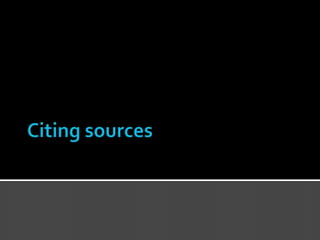
Citing sources*
- 2. Why do we cite? 3 reasons * In case the reader wants to find out more information (creates community of scholarship) To avoid plagiarism (give credit where credit is due) Establish credibility
- 3. When do we cite? Verbatim quotes Paraphrase – using any specific statistic or idea that is not your own How do we cite? Parenthetical citation ▪ (Smith, 2009, p. 23) Bibliographic citation References Hanson, G., Haridakis, P.M., Cunningham, A.W., Sharma, R., & Ponder, J.D. (2010). 2008 Presidential campaign: Political cynicism in the age of Facebook, MySpace and YouTube. Mass Communication & Society, 13(5), 584-607.
- 4. Style is tied to area of study MLA – Communication Studies, English, Linguistics, etc. (Many General Education Classes also use) APA – Social Sciences Chicago Style - History Handbooks provide formatting information Library citation guides Popular styles for communication studies: MLA APA Chicago Style
- 5. “Gilliom suggests” is called a signal phrase. (1994) is the parenthetical citation. Gilliom (1994) suggests that acceptance results from themarks are used to Quotation careful construction and framing of cut Use ellipses in brackets when you out text from the original, or insert text identify verbatim wording from issues. Hesource. the explains, “By construction, […] I that was not in the original. mean the social process of centering public This is another example of a attention (which may include the parenthetical citation. In APA style, use exaggeration of threats), defining the a “p.” then include the page number. Notice the punctuation here. problem, and prescribing ‘solutions’” (p. 19). Sample taken from: Simone, M. (2009). Give me liberty and give me surveillance: A case study of the U.S. Government’s discourse of surveillance. Critical Discourse Studies, 6(1), 1-14.
- 6. Fairclough (1995) states that critical discourse Quotes that are 4 lines or more are analysis indented. Quote marks are not needed aims to systematically explore often opaque because the indent signals to the relationships of causality and adetermination reader that this section is verbatim quote. between (a) discursive practices, events and texts, and (b) wider social and cultural structures, relations and processes; to investigate how such practices, events and Note the difference in texts arise out of and are ideologically shaped punctuation from the previous example. by relations of power and struggles over power. (p. 132) Sample taken from: Simone, M. (2009). Give me liberty and give me surveillance: A case study of the U.S. Government’s discourse of surveillance. Critical Discourse Studies, 6(1), 1-14.
- 7. Despite this recognition that government In this example, the citations are used surveillance can threaten civil liberties, to demonstrate to the reader that this citizens and their representatives can come claim can be found in and supported by the citations listed. to accept state surveillance as necessary, and even benign (Regan, 1995; Schrecker, 1998; Westin, 2003). Sample taken from: Simone, M. (2009). Give me liberty and give me surveillance: A case study of the U.S. Government’s discourse of surveillance. Critical Discourse Studies, 6(1), 1-14.
- 8. Quoting a quote – option 1 This page Gastil (2008) quotes Alan Bacan as reporting,from number is “’Most information about congressional which is Gastil, races the source you is found in smaller papers. Reporters working read, not the the congressional beat tend to be young quoted source and new to the profession’” (p. 96). by Gastil, which you did not read.
- 9. Quoting a quote – option 2 Alan Bacan reports, “’Most information about congressional races is found in smaller papers. Reporters working the congressional beat tend to be young and new to the profession’” (as cited by Gastil, 2008, p. 96).
- 10. Works cited (MLA) or References (APA) References ACLU. (2003, March 20). How Patriot Act II would further erode the basic checks on government power that keep America safe and free. Retrieved online March 27, 2003 from http://www.epic.org/privacy/terrorism/aclupatriot2.3.20.03.doc. Anderson, B. (2003). Imagined Communities (12th ed.). London: Verso. Blumer, H. (1972). Symbolic interaction: An approach to human communication. In R. W. Budd & B. D. Ruben (eds.), Approaches to Human Communication (pp. 401-419). New York: Spartan.
- 11. Notice the sources are arranged in alphabetical References is a hanging indent. order, and there ACLU. (2003, March 20). How Patriot Act II would further erode the basic checks on government power that keep America safe and free. Retrieved online March 27, 2003 from http://www.epic.org/privacy/terrorism/aclupatriot2.3.20.03.d oc. Internet source. Anderson, B. (2003). Imagined Communities (12th ed.). London: Verso. Book, beyond 1st edition Blumer, H. (1972). Symbolic interaction: An approach to human communication. In R. W. Budd & B. D. Ruben (eds.), Approaches to Human Communication (pp. 401-419). New York: Spartan. Book section
- 12. Foucault, M. (1995) Discipline and punish: The birth of the prison (A. Sheridan, trans.). New York: Vintage Books. Translated book. Graham, P., Keenan, T., and Dowd, A.M. (2004). A call to arms at the end of history: A discourse-historical analysis of George W. Bush's Declaration of War on Terror. Discourse & Society, 15(2-3), 199-221. Journal article Haughney, C. (2003, March 28). Protestors in New York stage ‘die-ins’; Hundreds arrested with spread of civil disobedience. The Washington Post, A1. Newspaper article
